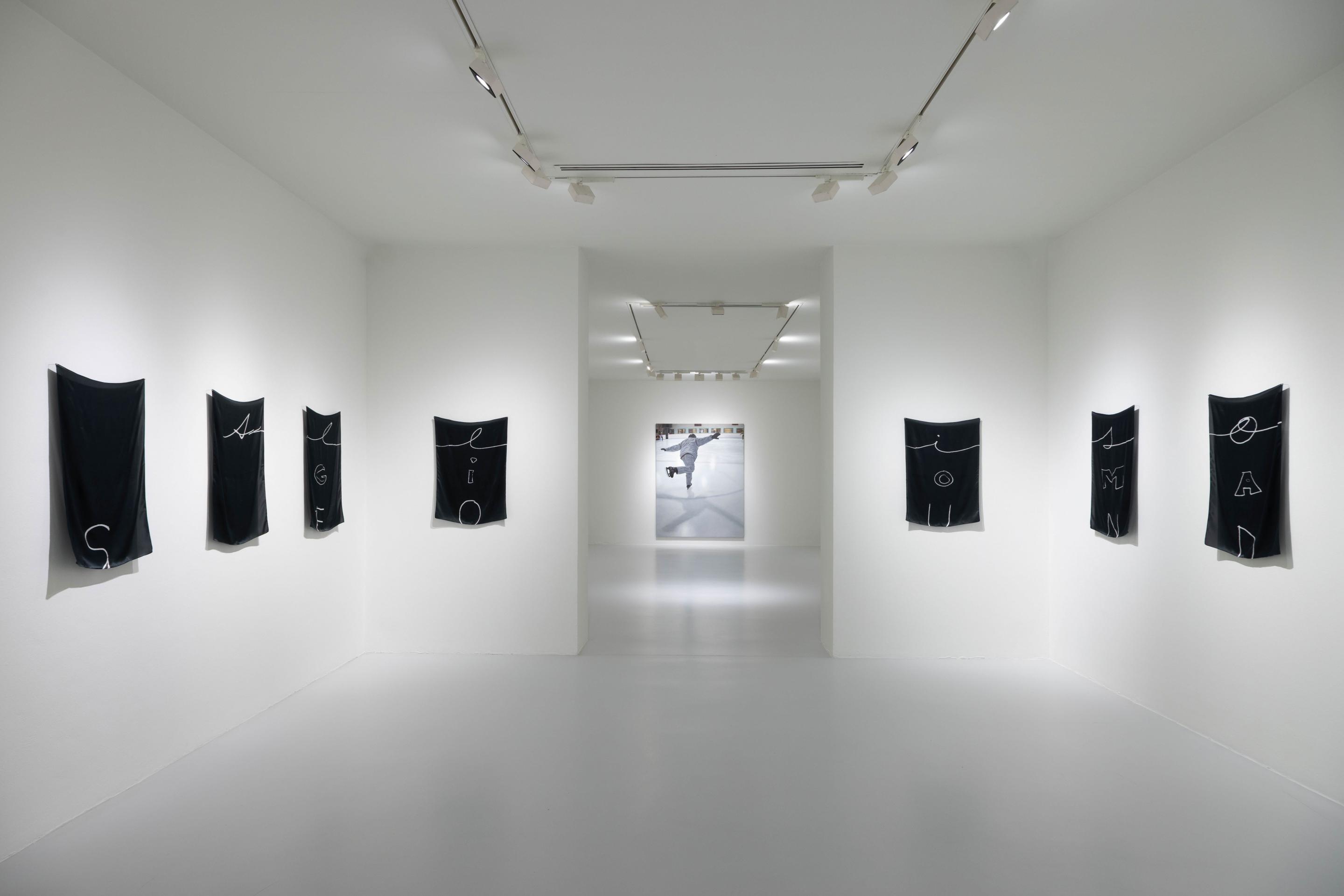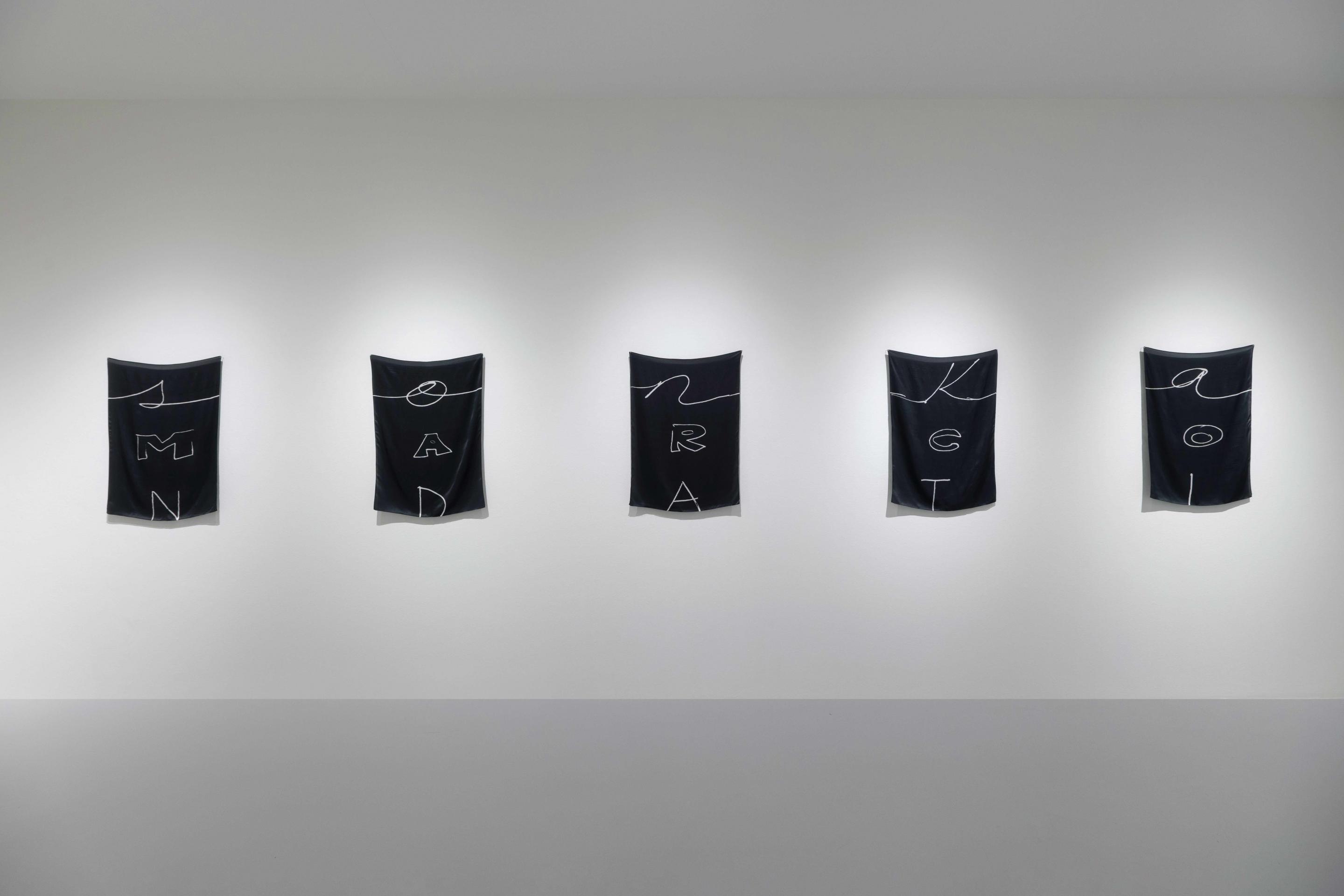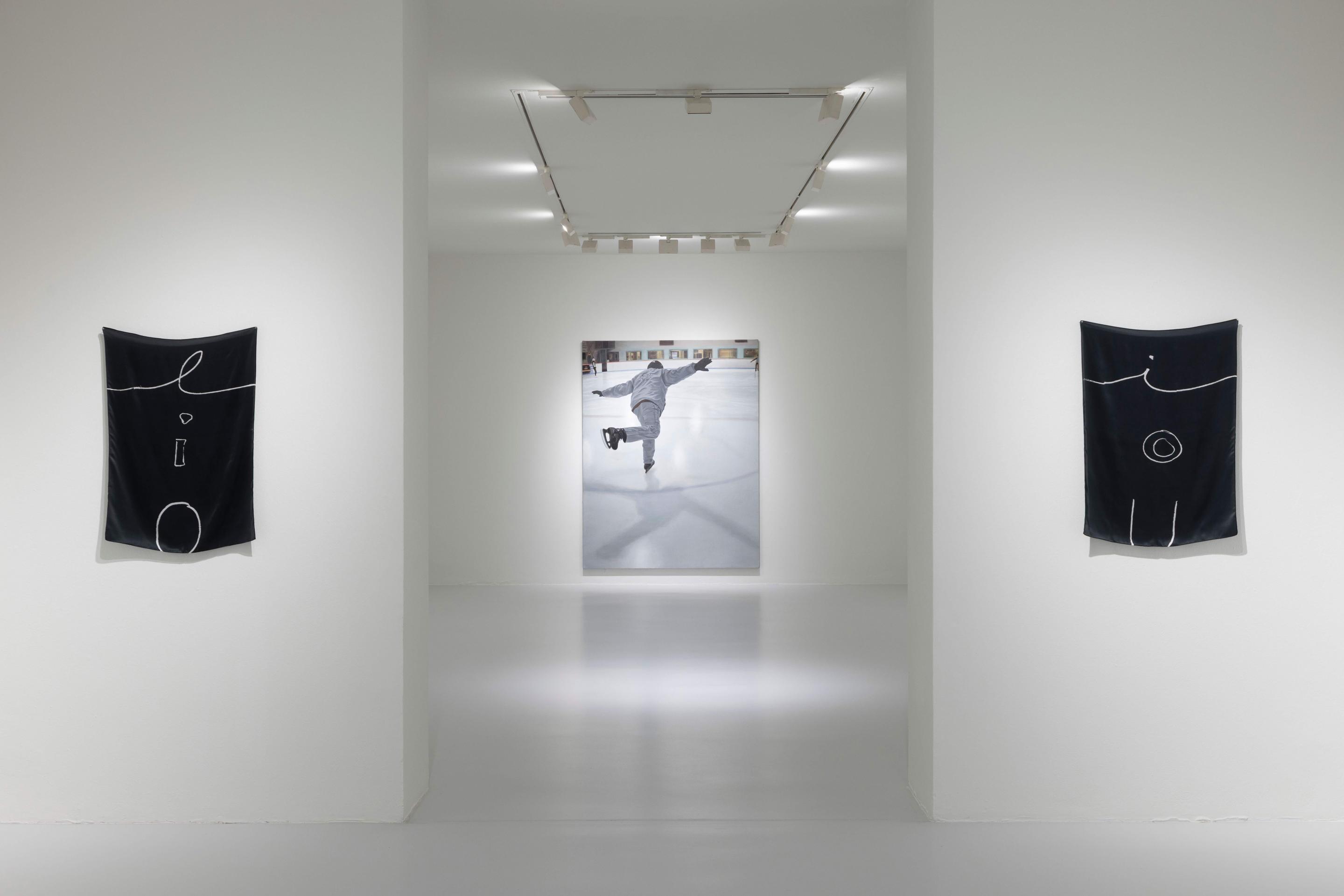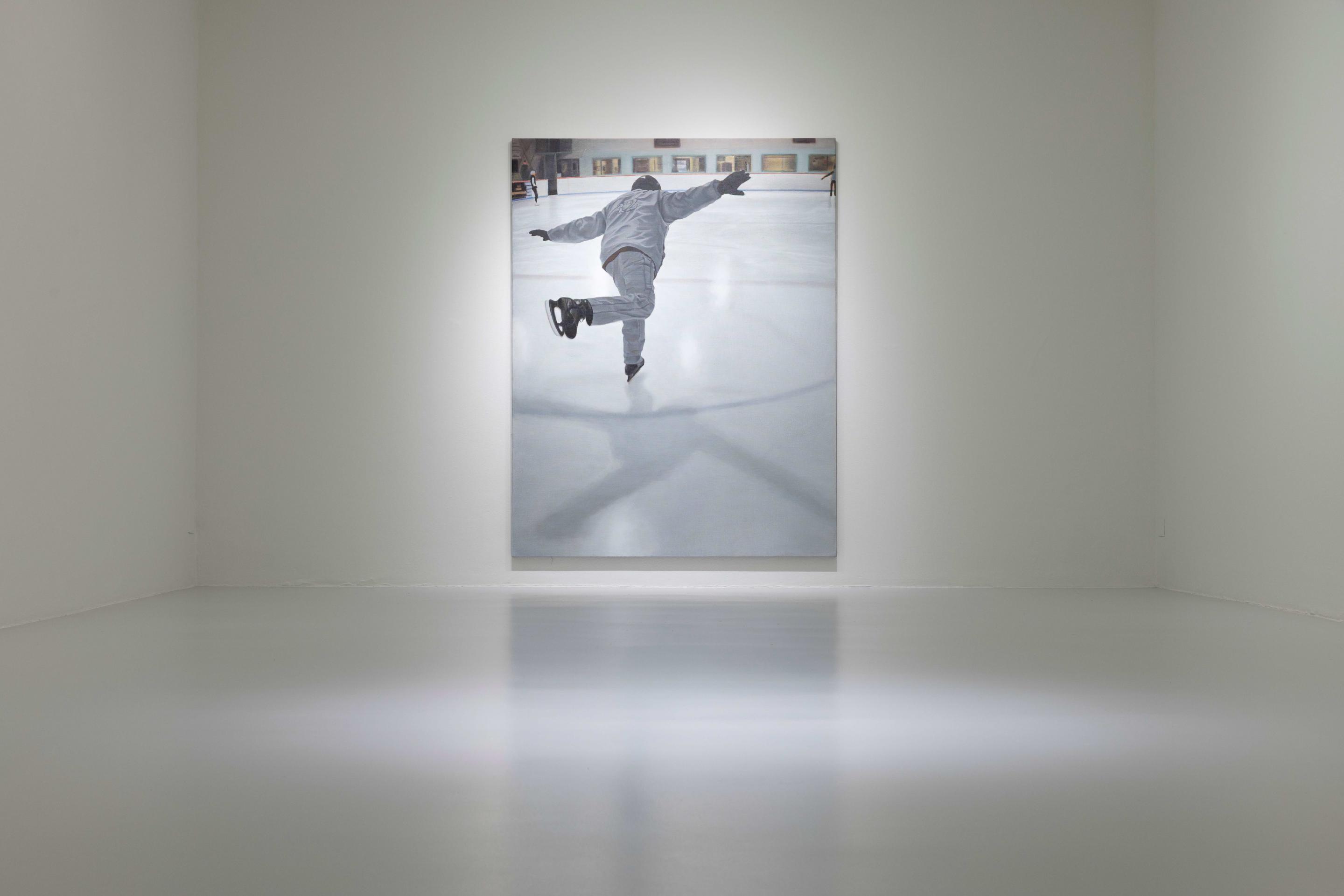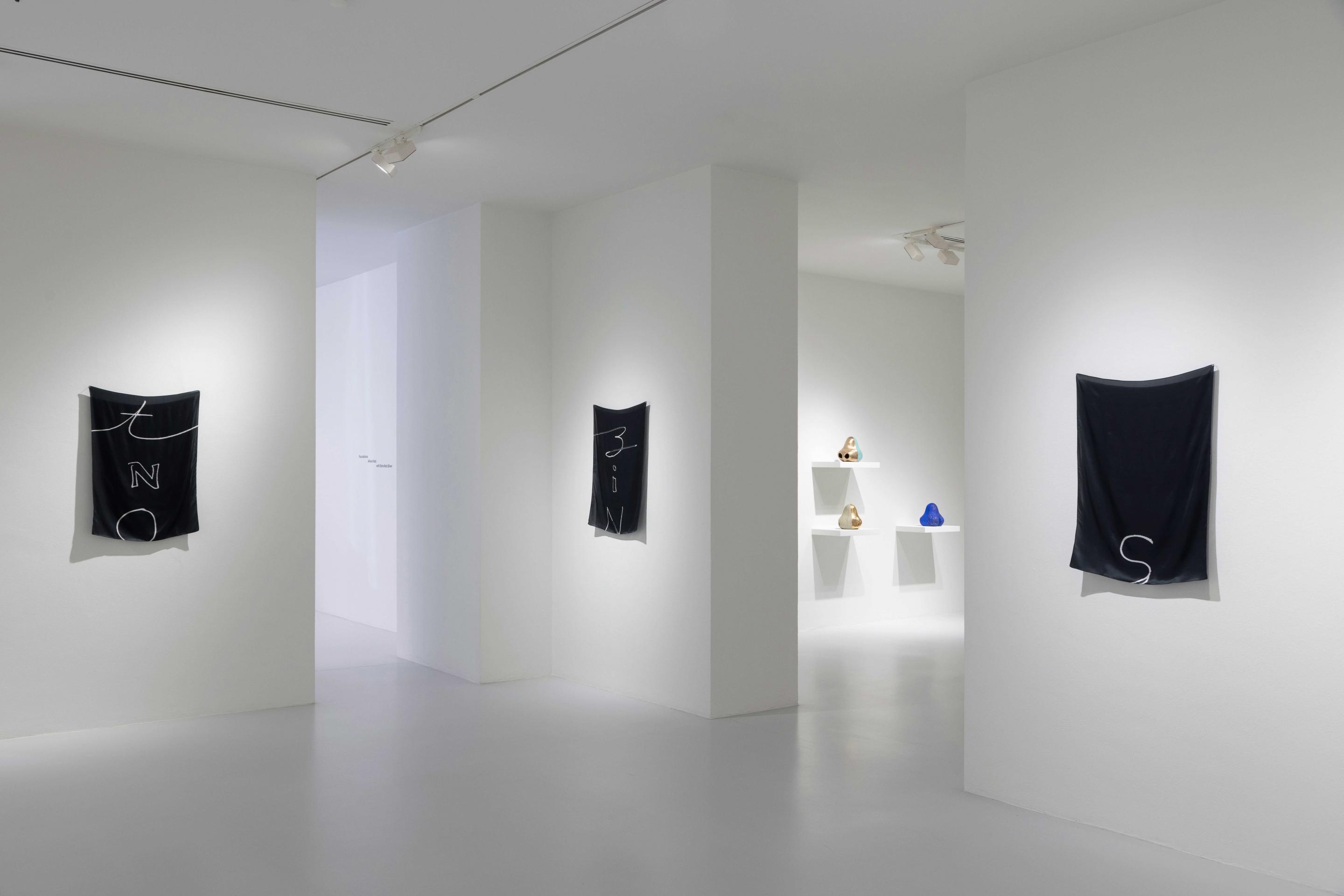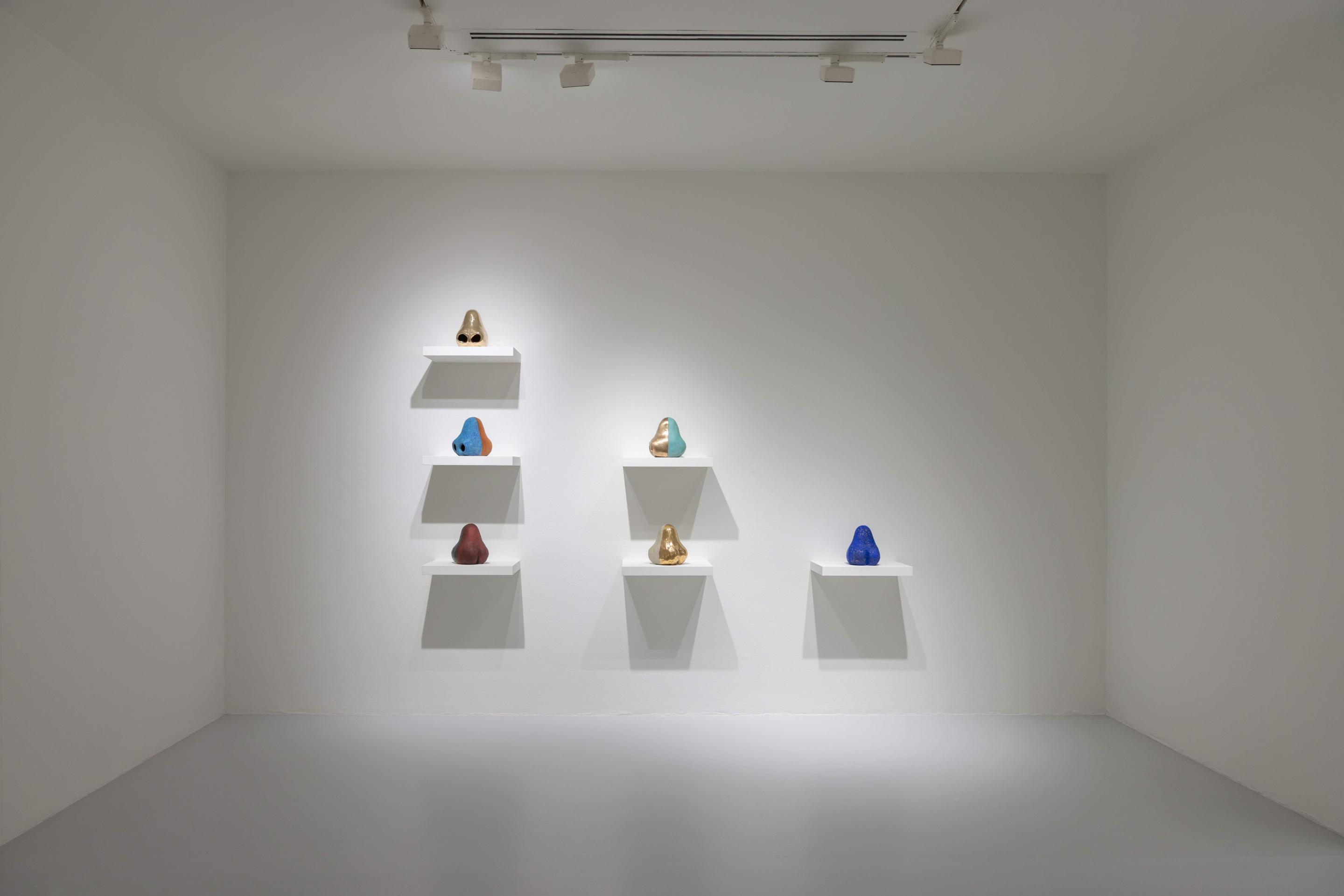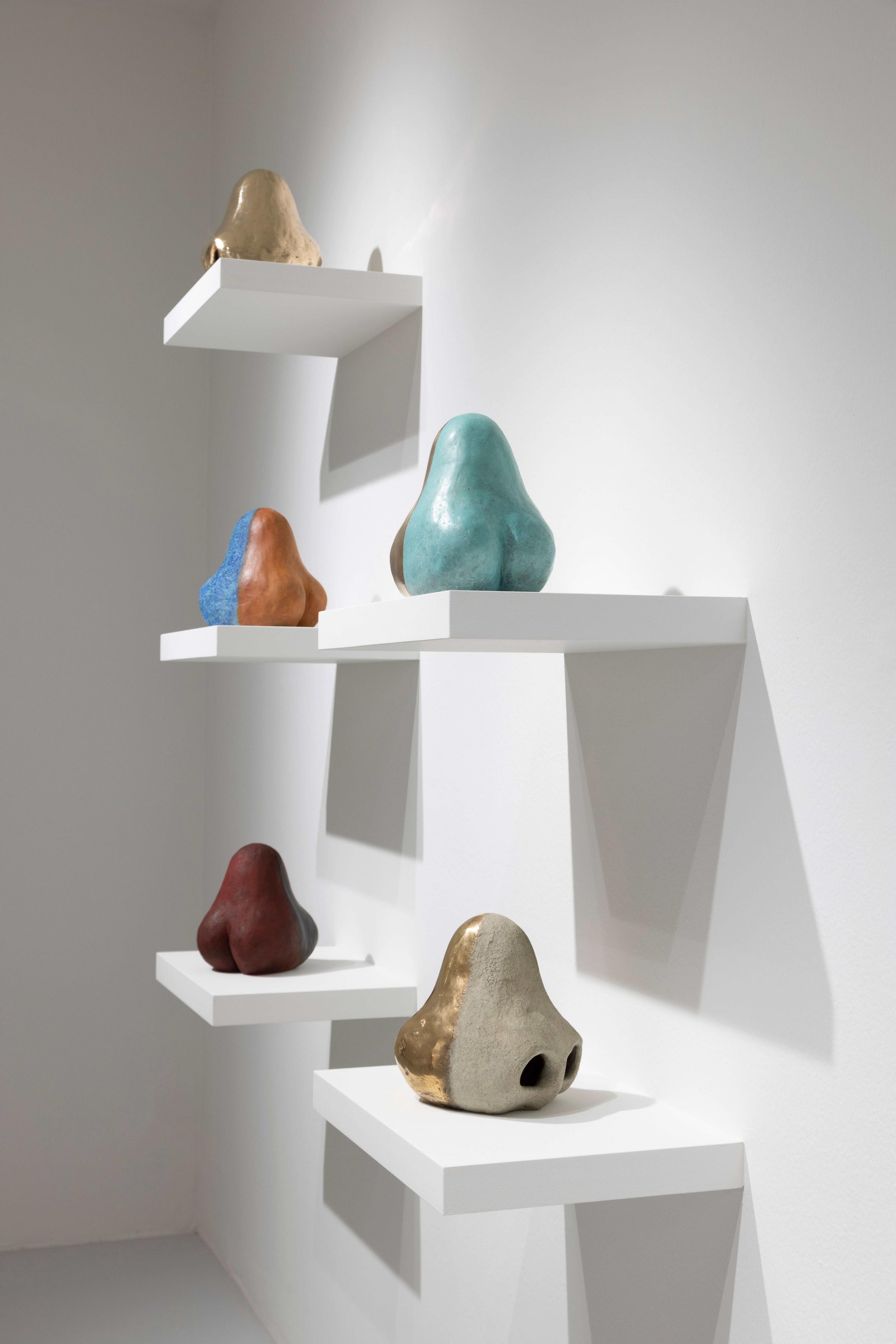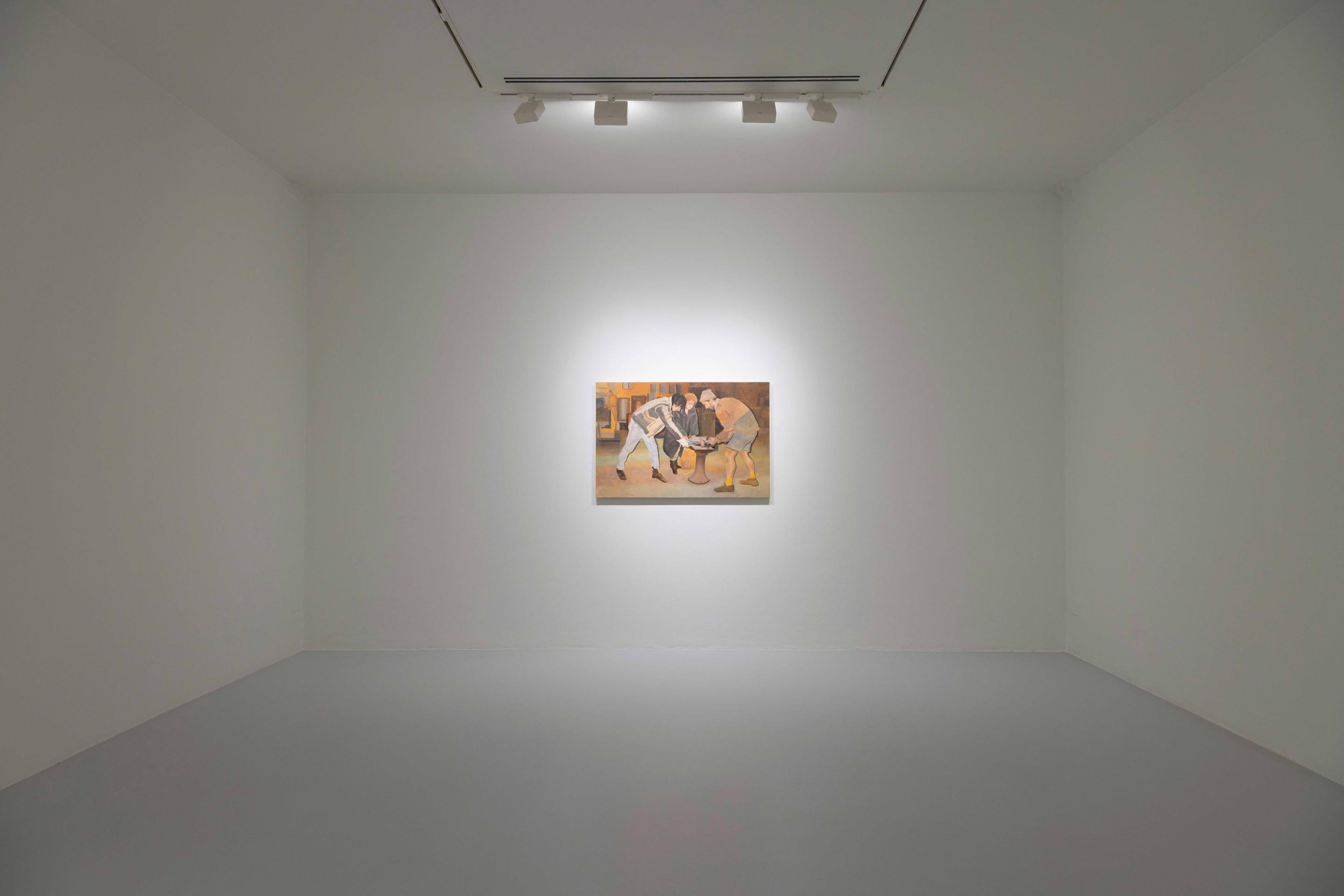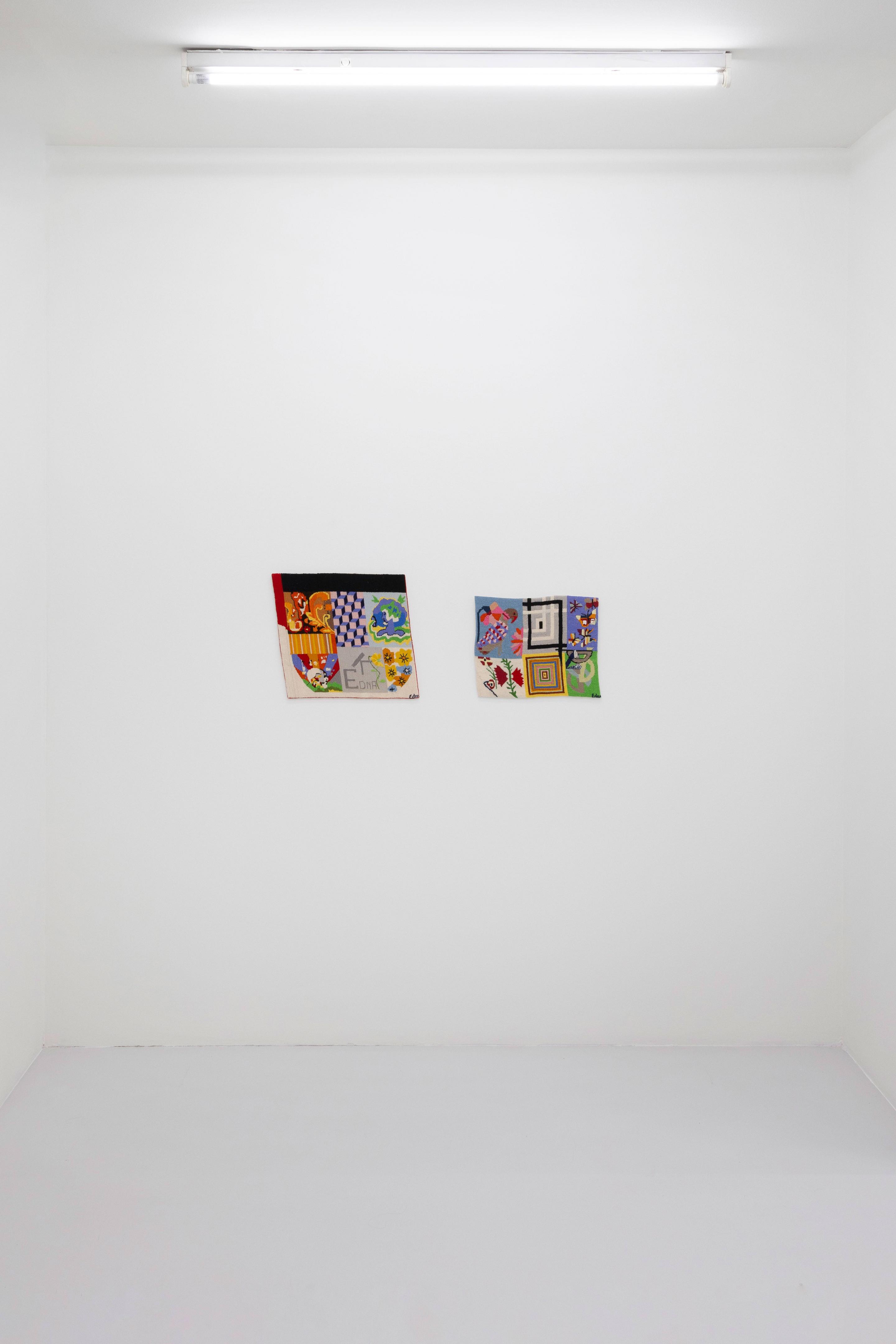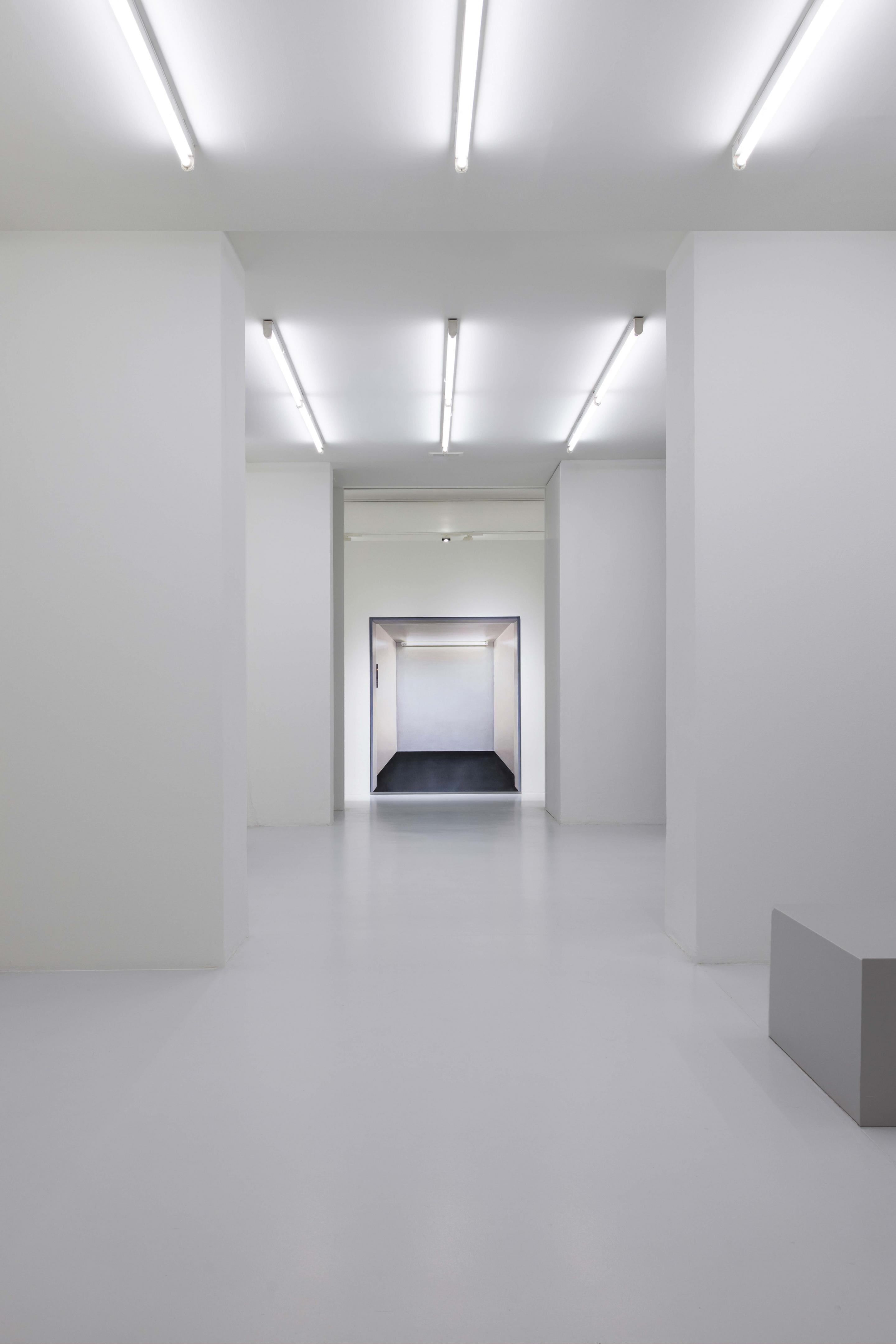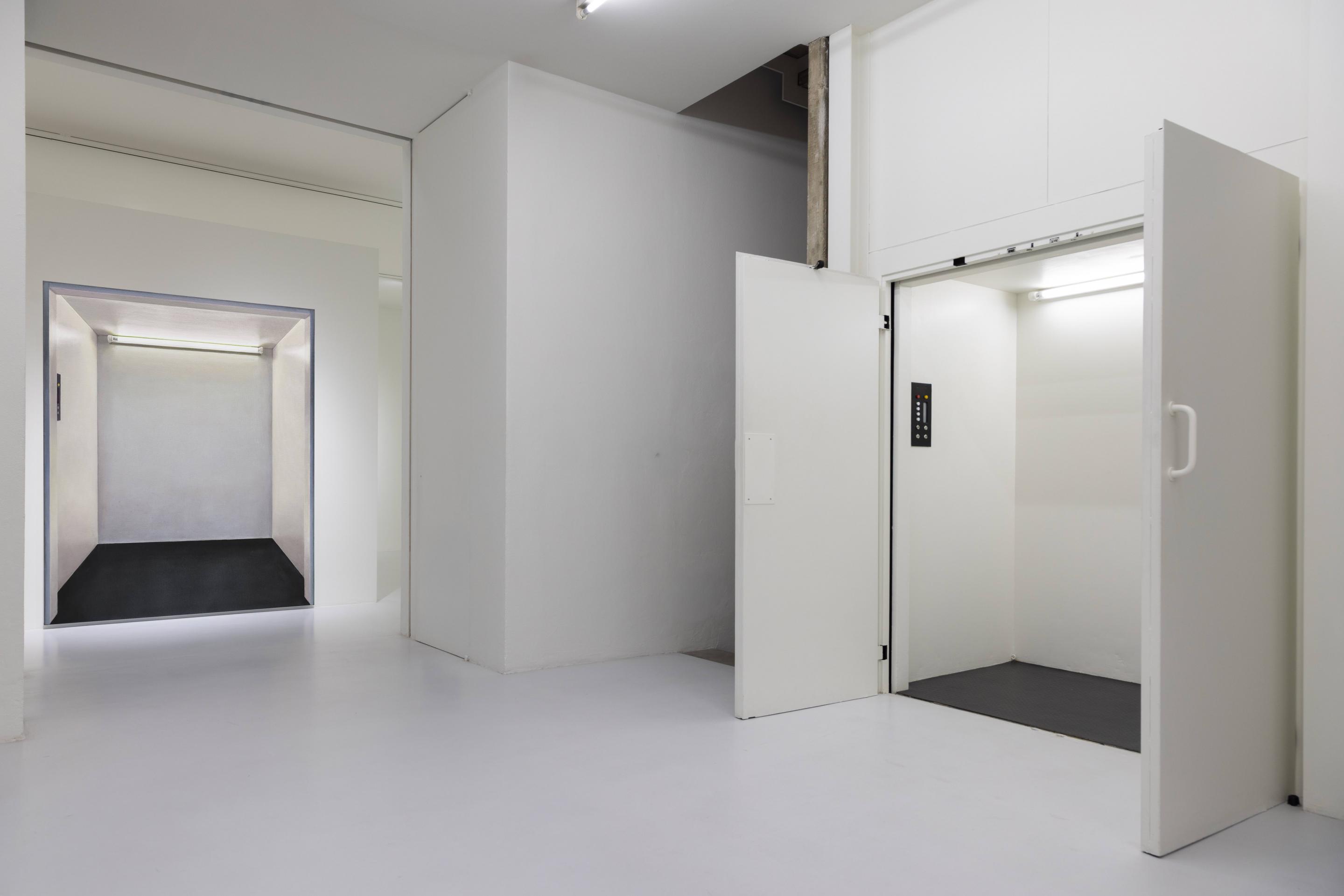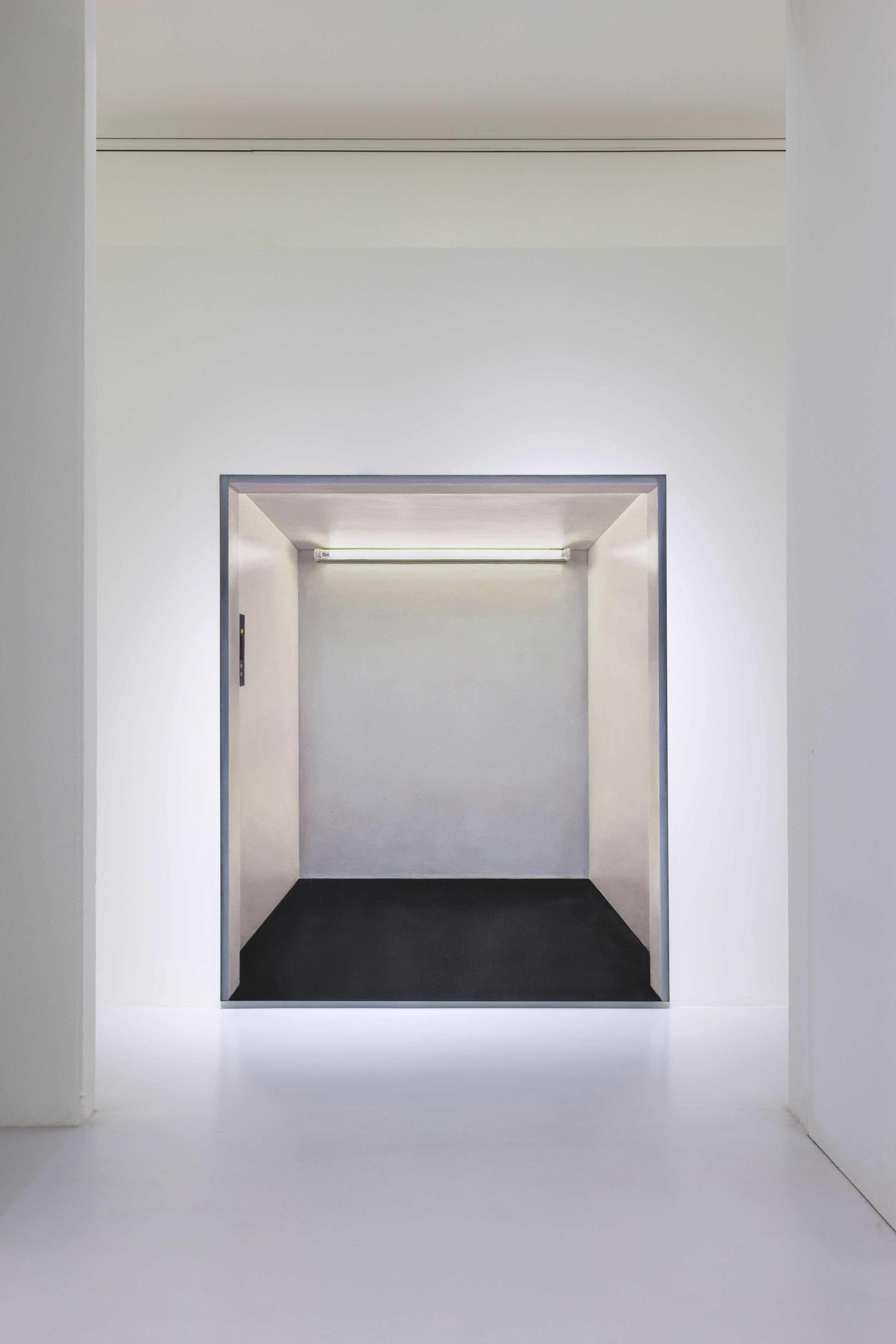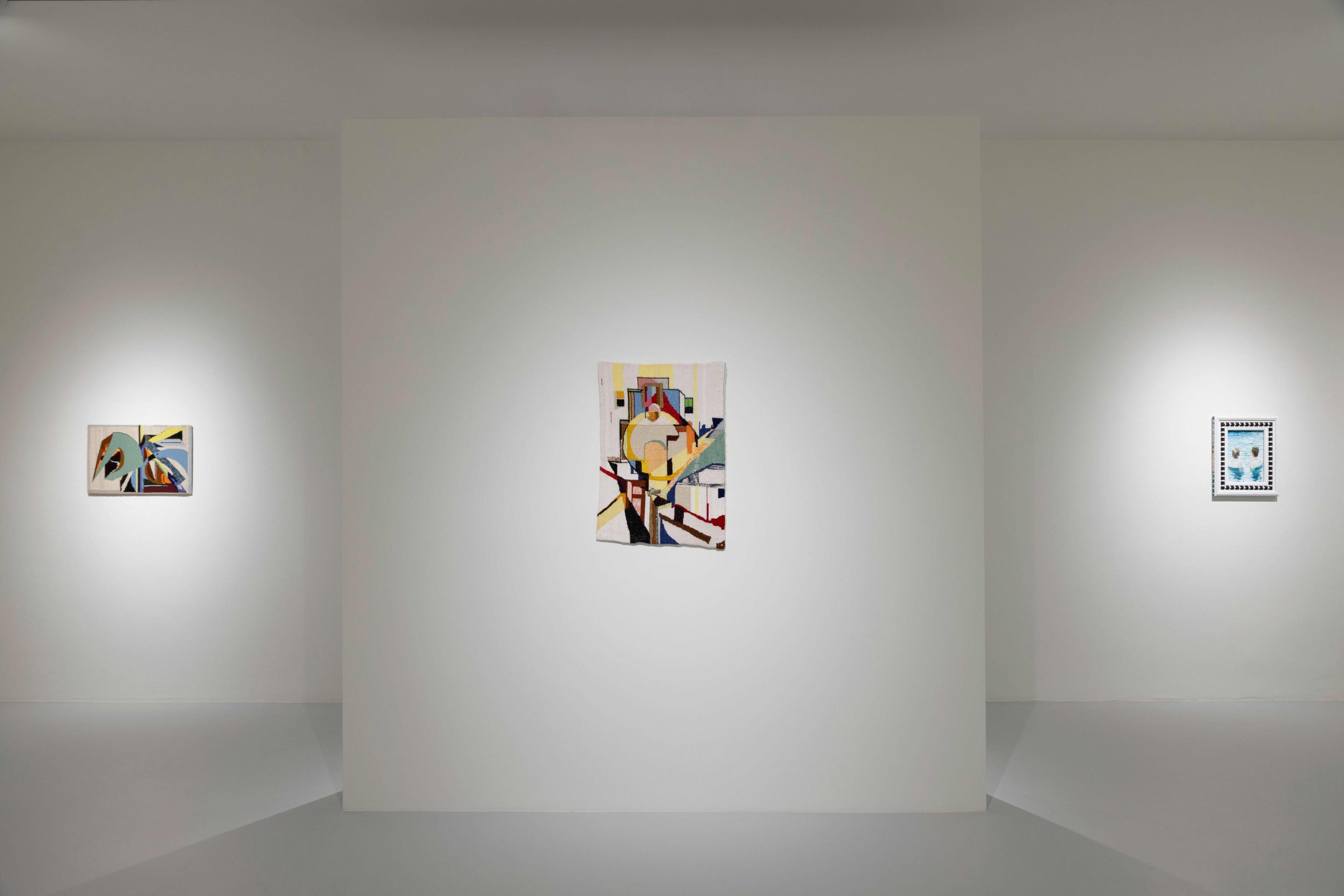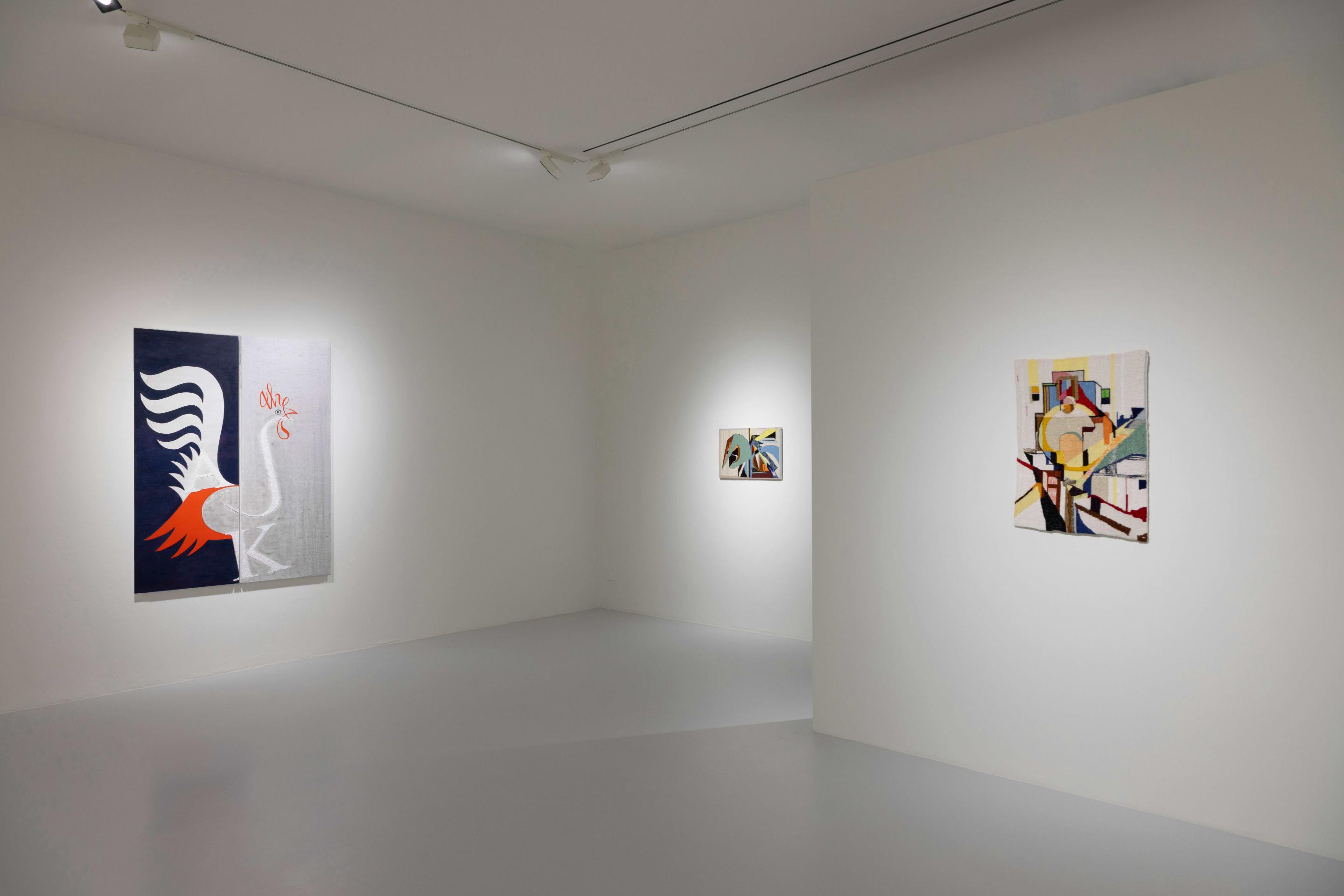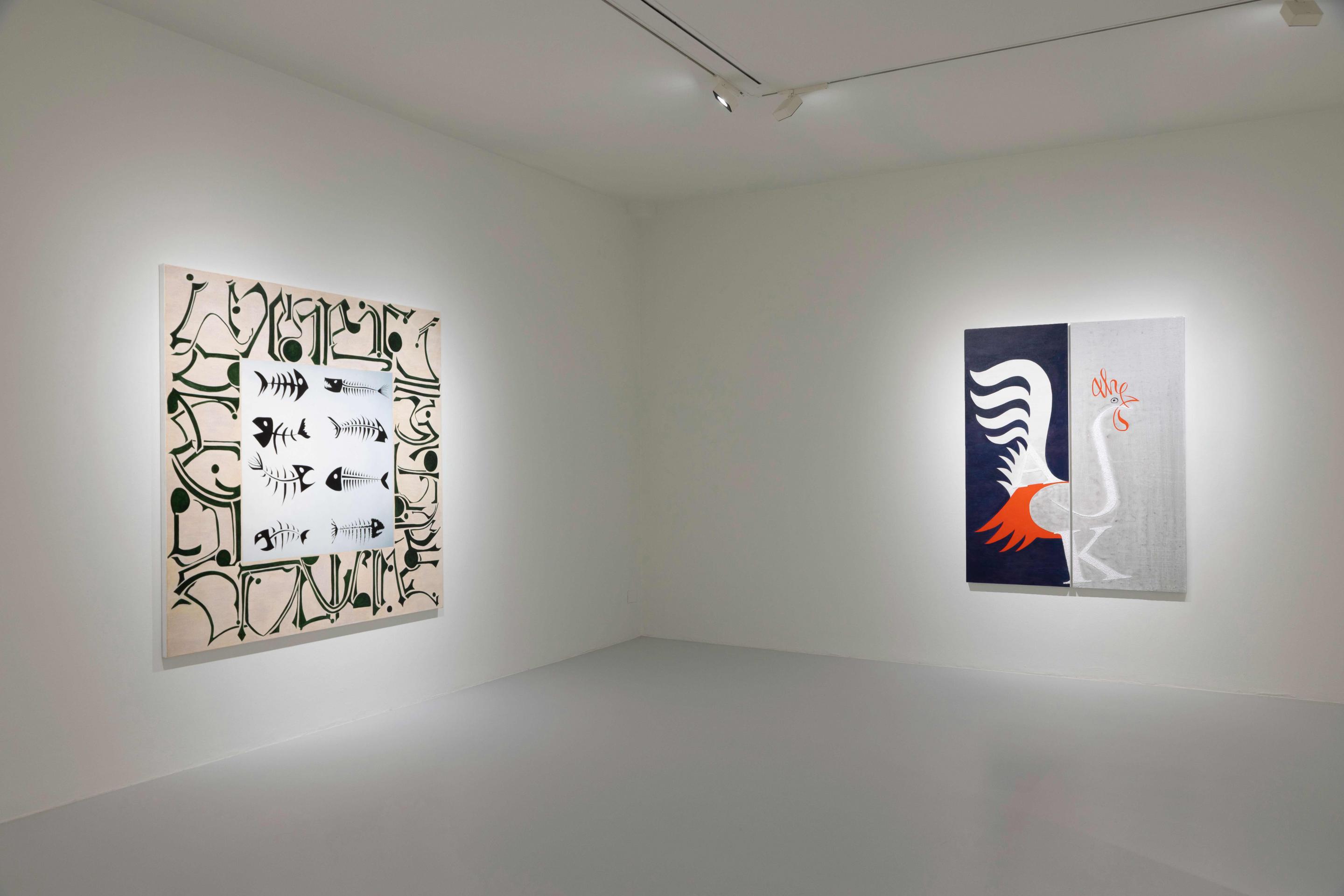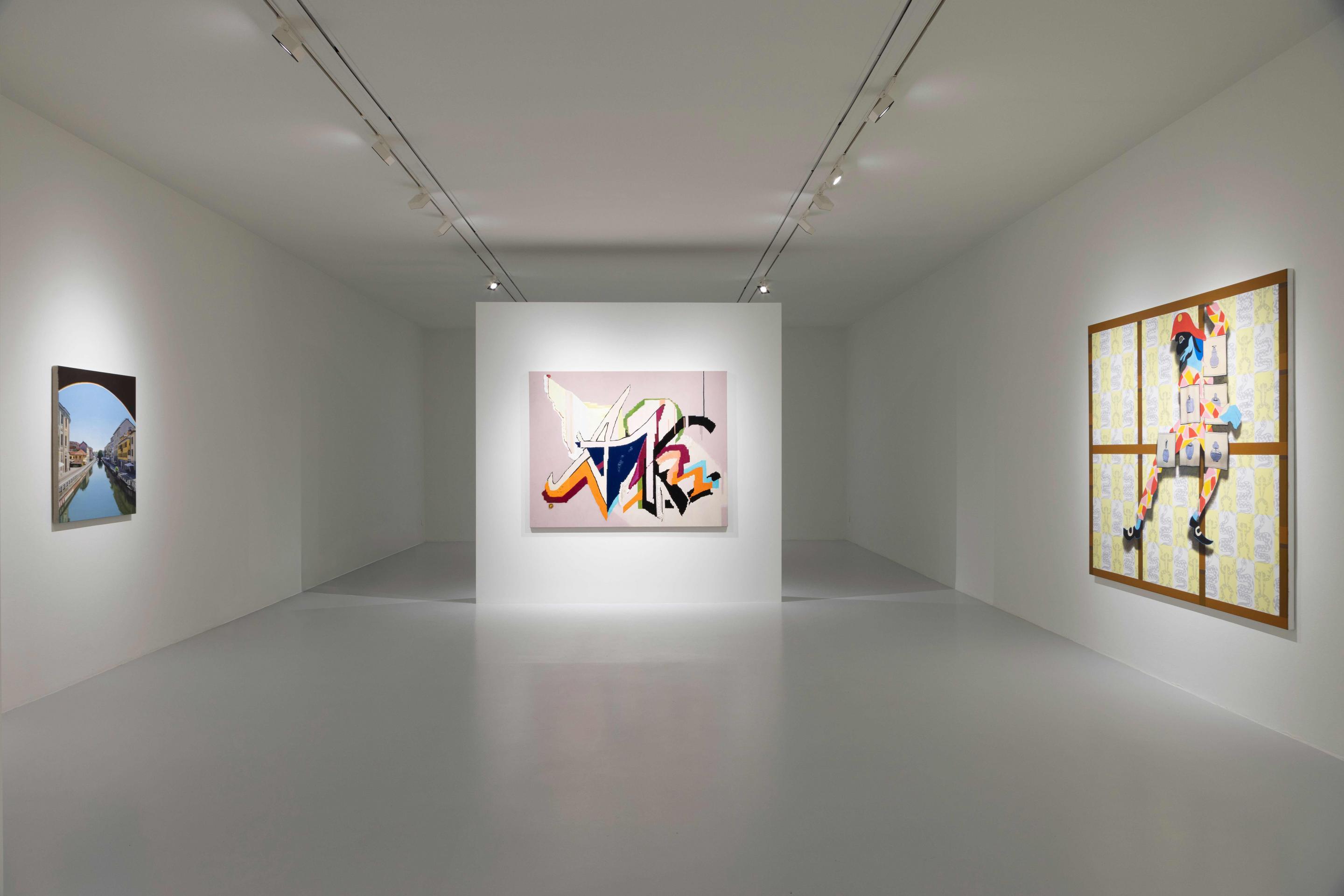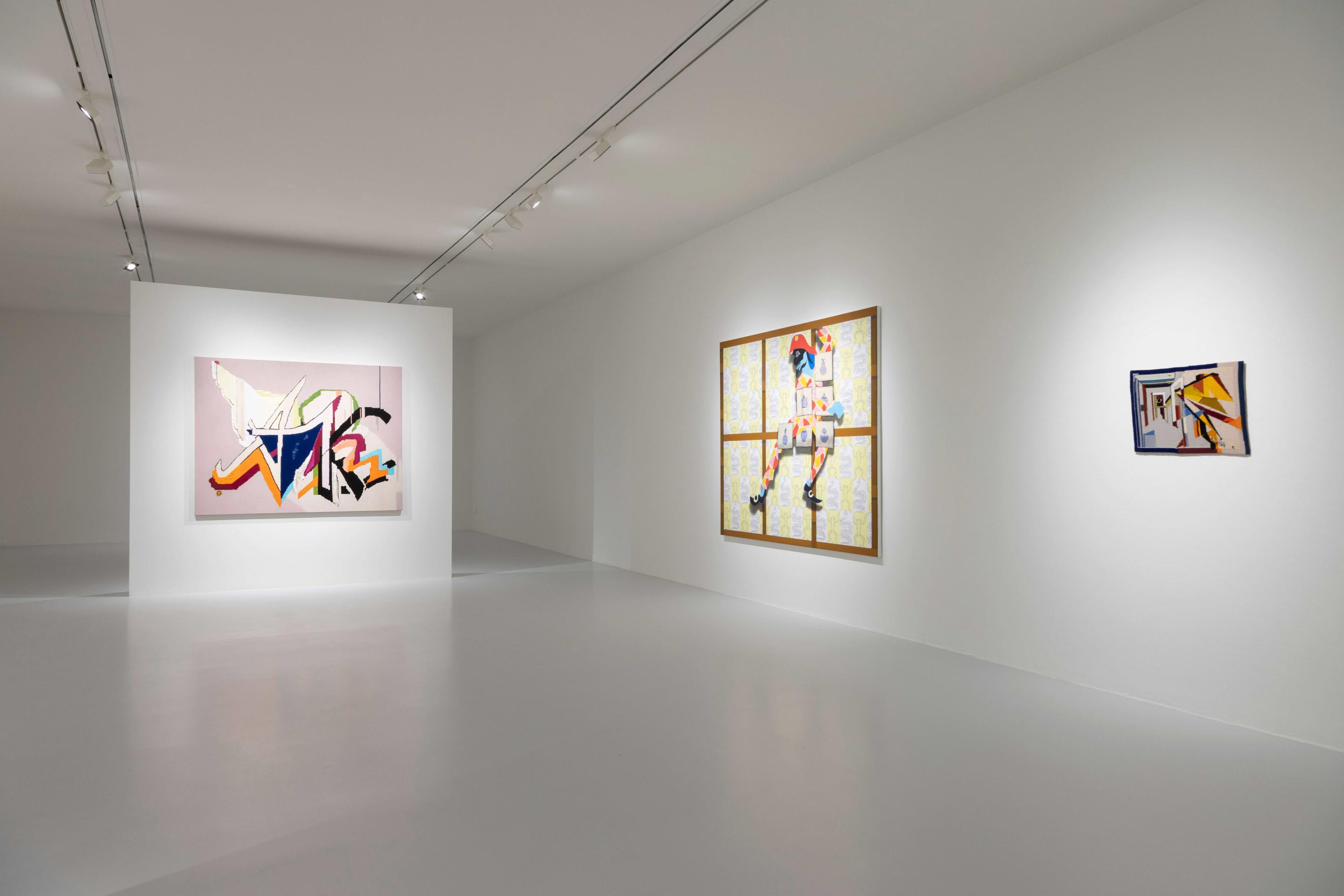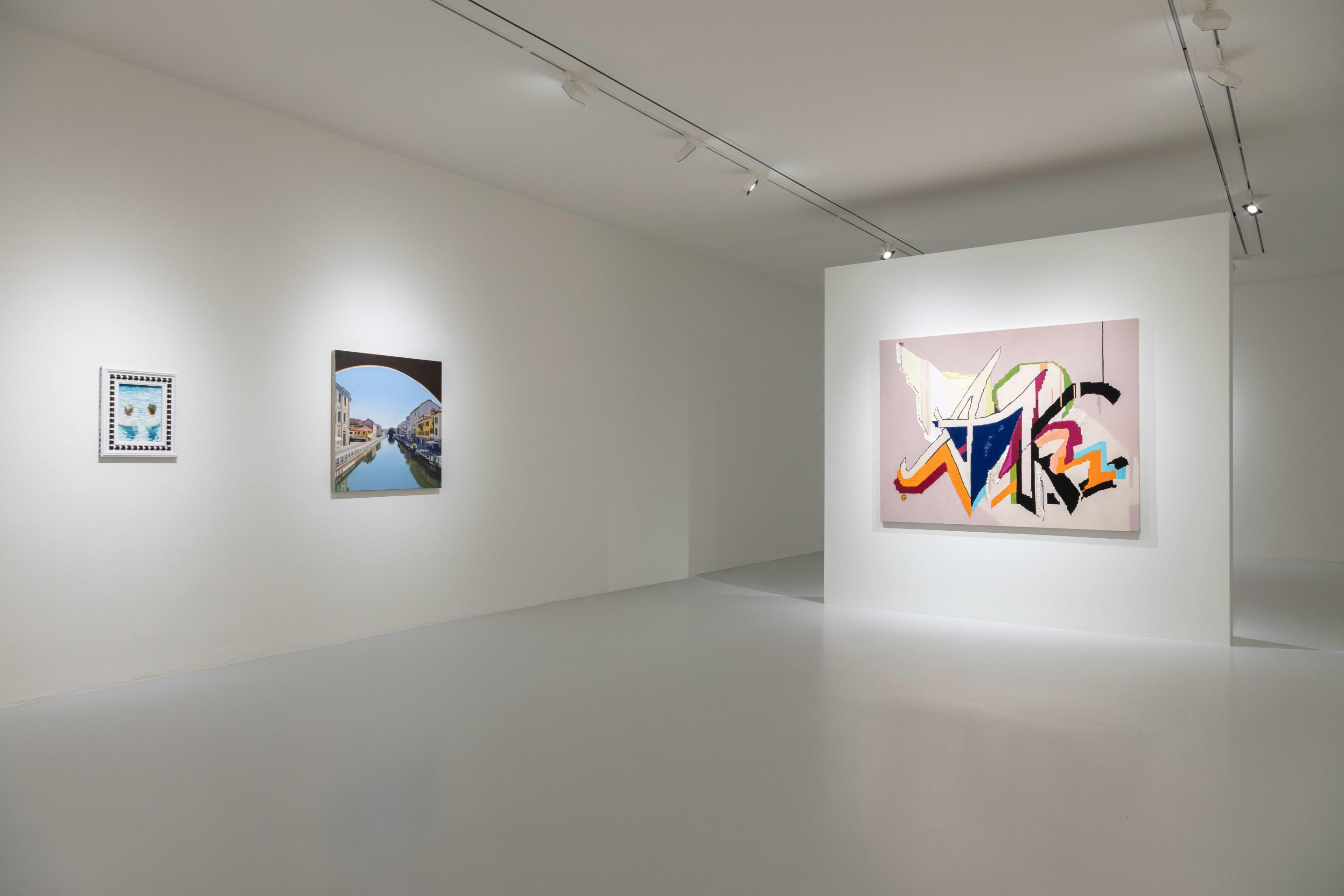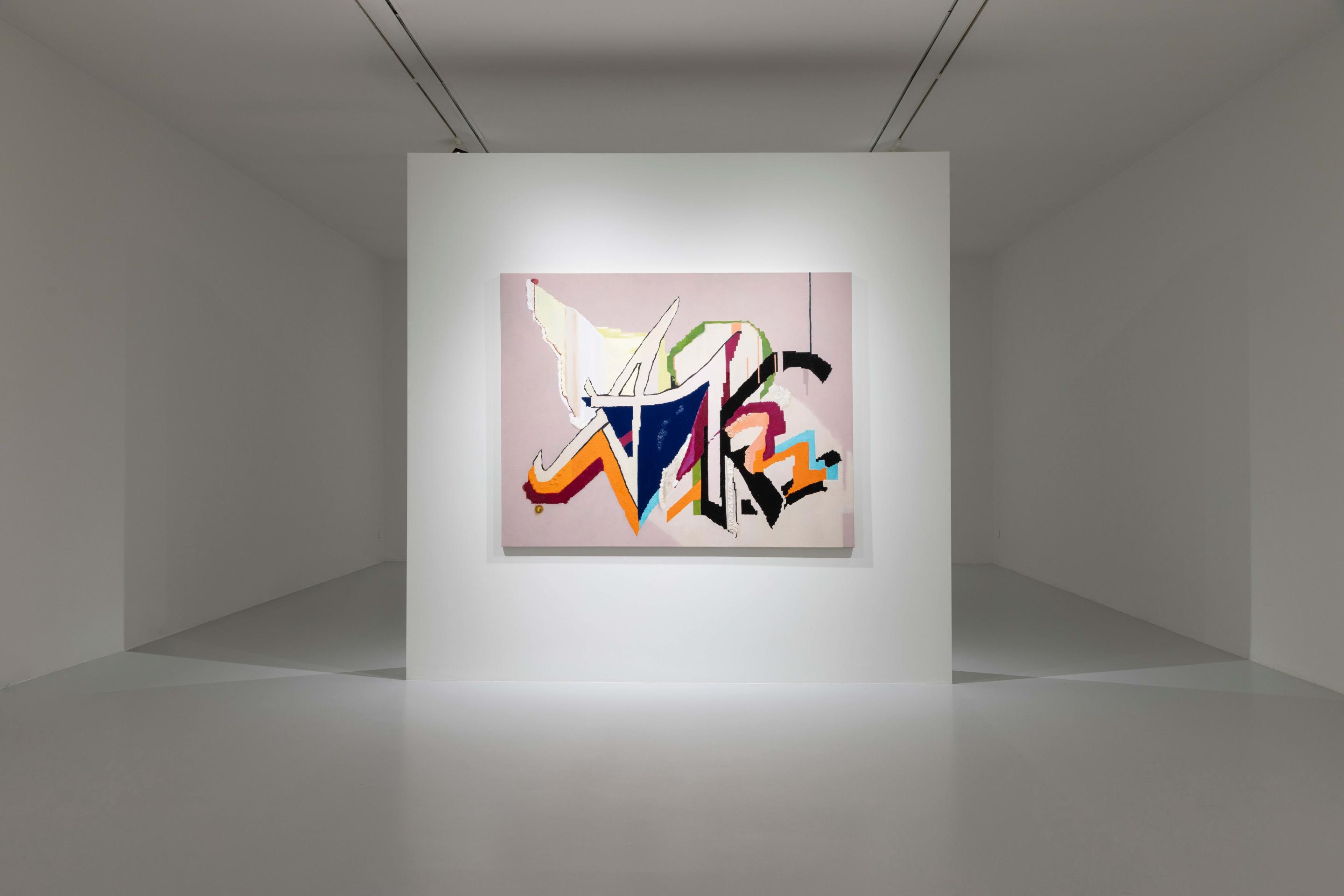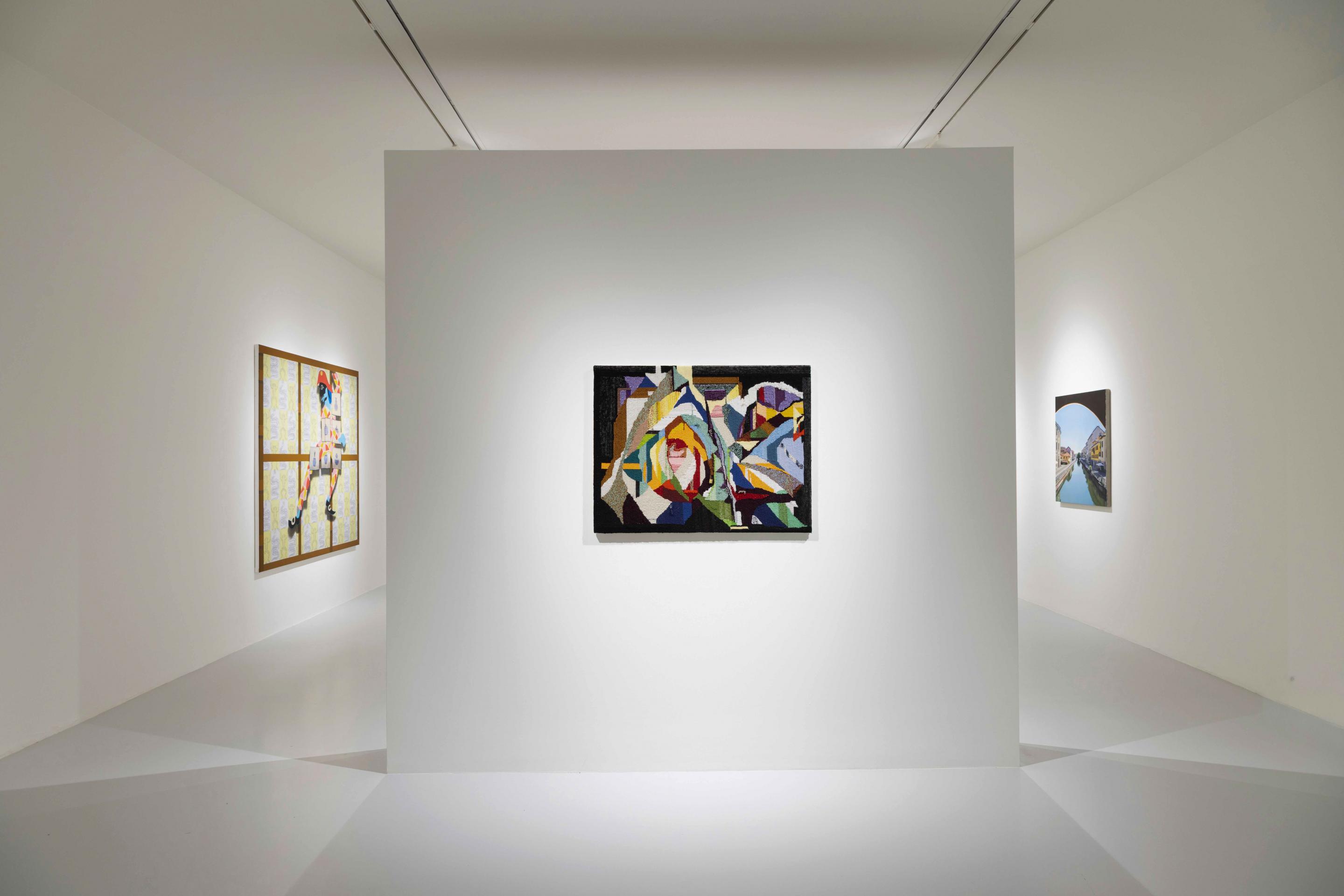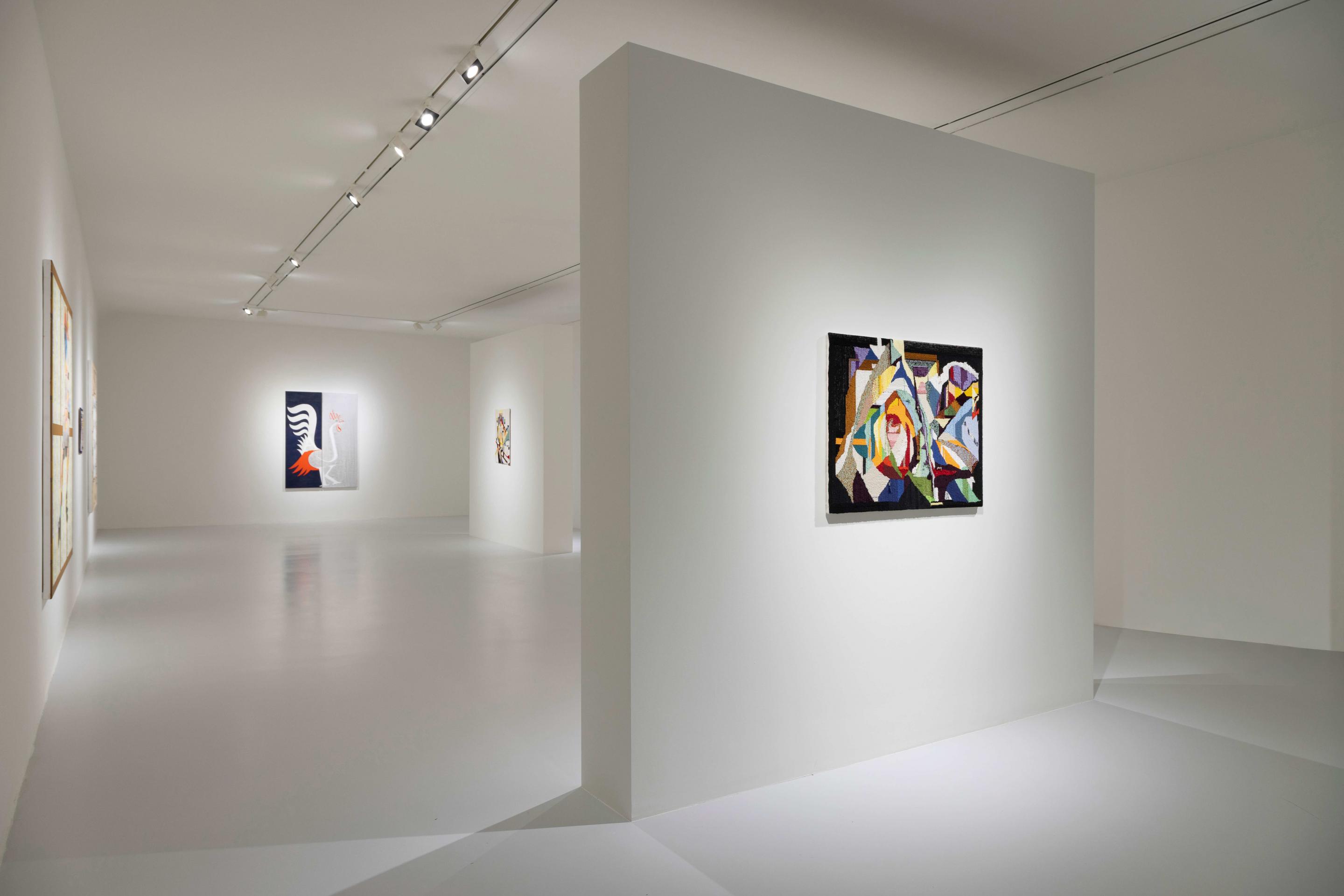AllisonKATZ
Foundations
Gió Marconi, Milan
02.10.–19.12.2025
Foundations
Gió Marconi, Milan
02.10.–19.12.2025
IT
Allison Katz
with Edna Katz Silver
Foundations
Inaugurazione: giovedì 2 ottobre 2025; 18-21
3 ottobre – 19 dicembre, 2025
martedì-sabato; 11-18
Era solo questione di tempo prima che Allison Katz realizzasse Foundations: una mostra che esplora il suo costante interrogarsi sul mito dell’artista e sui limiti della sua definizione come voce autonoma. “Non esiste una tela bianca”, afferma Katz. “Qualcosa è sempre già presente, a partire dall’inconscio (l’ineffabile). Poi arrivano i mattoni del nostro DNA, le condizioni strutturali, i corpi delle persone amate, i fantasmi di chi non c’è più, e ogni quadro già dipinto. Tutte queste forze contribuiscono a formare gusti, piaceri e paure: un autoritratto costruito dagli altri. Le fondamenta sono i nostri inizi, le radici che giacciono sottoterra – ed è lo stesso termine (in inglese almeno) per ciò che può accadere alla fine, con la costruzione di un’eredità.”
Per dare forma a uno degli aspetti di questa rete di influenze, Katz invita la nonna paterna, l’artista novantenne Edna Katz Silver, a presentare una serie di ricami come parte integrante della mostra. Allo stesso tempo, coinvolge nel suo percorso il suo storico gallerista, Gió Marconi, e la storia della sua famiglia. “Osservando più da vicino ciò che è sempre stato presente, ho invitato mia nonna Edna a condividere con me questa mostra personale.” È stato un modo per realizzare uno scambio reciproco iniziato quasi dieci anni fa, quando per la prima volta le chiesi di realizzare una composizione a mezzo punto basata sulla mia firma.” Motivo ricorrente in molti dei suoi dipinti, il nome di Katz attraversa l’intera esposizione, permettendo di indagare quali tratti del suo passato biografico si siano trasmessi, intenzionalmente o meno, nella sua arte.
A sua volta, attraverso immagini tratte da foulard e cornici create dagli antenati di Gió Marconi, una discendenza di corniciai e produttori di tessuti divenuti galleristi, Katz solleva interrogativi sullo stile e sulla vocazione ereditati. Per l’artista, la cornice e l’ornamento non sono semplici rimandi biografici, ma un’occasione per riflettere su ciò che costituisce la base stessa della pittura. “Il profilo della cornice rappresenta le prime quattro linee di qualsiasi immagine”, spiega. “Inquadrare significa interrompere l’infinito, estrarre la trama della vita dal continuum.” Lo stesso vale per il formato arabescato del foulard decorativo, un altro leitmotiv che attraversa la mostra. Il decoro si concentra solo sui margini o sui bordi, circondando e provocando il centro, oppure lasciandolo vuoto.
Dipinti, stampe, tessuti e sculture si susseguono in sequenza, non lineare, dando forma ai racconti di numerosi incontri fortuiti e delle loro conseguenze. Le fondamenta che questi lavori mettono a nudo non sono strutture solide e durature, ma piuttosto capricciose, mobili e generative.
—Yuval Etgar
Edna Katz Silver
Edna Katz Silver, primogenita di tre figlie, nasce a Montréal nel 1930. I suoi genitori, fuggiti da uno shtetl nell’attuale Ucraina, erano emigrati in Canada. La famiglia si era trasferita inizialmente in un locale industriale, dove condivideva lo spazio abitativo con la nascente attività tessile del padre David Applebaum, che in seguito si sarebbe trasformata in una fiorente fabbrica di copriletti in ciniglia. La madre, Bella, cuciva e lavorava a maglia gli abiti per le figlie. Edna mostrò fin da piccola una naturale predisposizione per il cucito, unita a uno sviluppato gusto per il design. Tessuti, texture e abiti su misura costituirono le fondamenta della sua infanzia, così come della sopravvivenza familiare.
A ottantasette anni Edna realizzò per me il suo primo ricamo a punto croce. Nell’arco della sua vita non aveva mai conosciuto una vera distanza da questa pratica, ma piuttosto una trasformazione: l’intensità delle esperienze accumulate aveva riacceso in lei un interesse che non coltivava da decenni. Nel corso della sua carriera, Edna ha conosciuto ed esplorato quasi tutti i linguaggi artistici: dalla pittura alla grafica, dalla scultura alla gioielleria. Ha rivestito molteplici ruoli professionali e imprenditoriali: insegnante, cofondatrice di gallerie autogestite, designer di mobili e di sculture pubbliche all’aperto, fino ad avvicinarsi, più tardi nella sua carriera, alla recitazione cinematografica. I suoi ricami sono trame che custodiscono frammenti della sua storia personale (letteralmente, in quanto talvolta li realizza con le sete provenienti dal laboratorio del padre) e dei suoi molteplici interessi. Forme geometriche, linee architettoniche, ornamento e decorazione, trovano espressione nell’atto primordiale del cucire con ago e filo.
—Allison Katz
Allison Katz
Allison Katz (n. 1980, Montréal, Canada) vive e lavora a Londra. Ha studiato Belle Arti presso la Concordia University di Montréal e ha conseguito successivamente un Master Fine Arts alla Columbia University di New York. La pratica di Katz indaga i diversi modi in cui le pratiche estetiche mettono in relazione e assimilano autobiografia, sistemi di informazione, icone grafiche e storia dell’arte. Il suo vocabolario eterogeneo di motivi, che include galli, cavoli, bocche, ascensori, nasi e la scrittura del proprio nome, appare come una costellazione di segni ricorrenti che costruiscono un insieme di idee e riferimenti, declinandosi attraverso la pittura, poster e installazione. Katz ha presentato mostre personali in importanti istituzioni internazionali, tra cui l’Art Gallery of Ontario (Toronto, 2025), il Camden Art Centre (Londra, 2022), il Nottingham Contemporary (Nottingham, 2021) e il MIT List Visual Arts Center (Cambridge, 2018). Nel 2026 terrà una mostra personale al Musée des Beaux-Arts di Montréal. Tra le recenti mostre collettive si ricordano From Cindy Sherman to Francesco Vezzoli: 80 Contemporary Artists (Palazzo Reale, Milano, 2025), In Focus: A Closer Look at Photorealism (Centraal Museum, Utrecht, 2024), Capturing the Moment (Tate Modern, Londra, 2024) e The Milk of Dreams, 59. Esposizione Internazionale d’Arte, Biennale di Venezia (2022). Nel 2024 ha curato e partecipato alla grande mostra collettiva In the House of the Trembling Eye (Aspen Art Museum, 2024). Ha ricevuto numerosi riconoscimenti, tra cui il Gershon Iskowitz Prize presso l’AGO (2023) e la Pompeii Commitments – Archaeological Matters digital fellowship (2022).
with Edna Katz Silver
Foundations
Inaugurazione: giovedì 2 ottobre 2025; 18-21
3 ottobre – 19 dicembre, 2025
martedì-sabato; 11-18
Era solo questione di tempo prima che Allison Katz realizzasse Foundations: una mostra che esplora il suo costante interrogarsi sul mito dell’artista e sui limiti della sua definizione come voce autonoma. “Non esiste una tela bianca”, afferma Katz. “Qualcosa è sempre già presente, a partire dall’inconscio (l’ineffabile). Poi arrivano i mattoni del nostro DNA, le condizioni strutturali, i corpi delle persone amate, i fantasmi di chi non c’è più, e ogni quadro già dipinto. Tutte queste forze contribuiscono a formare gusti, piaceri e paure: un autoritratto costruito dagli altri. Le fondamenta sono i nostri inizi, le radici che giacciono sottoterra – ed è lo stesso termine (in inglese almeno) per ciò che può accadere alla fine, con la costruzione di un’eredità.”
Per dare forma a uno degli aspetti di questa rete di influenze, Katz invita la nonna paterna, l’artista novantenne Edna Katz Silver, a presentare una serie di ricami come parte integrante della mostra. Allo stesso tempo, coinvolge nel suo percorso il suo storico gallerista, Gió Marconi, e la storia della sua famiglia. “Osservando più da vicino ciò che è sempre stato presente, ho invitato mia nonna Edna a condividere con me questa mostra personale.” È stato un modo per realizzare uno scambio reciproco iniziato quasi dieci anni fa, quando per la prima volta le chiesi di realizzare una composizione a mezzo punto basata sulla mia firma.” Motivo ricorrente in molti dei suoi dipinti, il nome di Katz attraversa l’intera esposizione, permettendo di indagare quali tratti del suo passato biografico si siano trasmessi, intenzionalmente o meno, nella sua arte.
A sua volta, attraverso immagini tratte da foulard e cornici create dagli antenati di Gió Marconi, una discendenza di corniciai e produttori di tessuti divenuti galleristi, Katz solleva interrogativi sullo stile e sulla vocazione ereditati. Per l’artista, la cornice e l’ornamento non sono semplici rimandi biografici, ma un’occasione per riflettere su ciò che costituisce la base stessa della pittura. “Il profilo della cornice rappresenta le prime quattro linee di qualsiasi immagine”, spiega. “Inquadrare significa interrompere l’infinito, estrarre la trama della vita dal continuum.” Lo stesso vale per il formato arabescato del foulard decorativo, un altro leitmotiv che attraversa la mostra. Il decoro si concentra solo sui margini o sui bordi, circondando e provocando il centro, oppure lasciandolo vuoto.
Dipinti, stampe, tessuti e sculture si susseguono in sequenza, non lineare, dando forma ai racconti di numerosi incontri fortuiti e delle loro conseguenze. Le fondamenta che questi lavori mettono a nudo non sono strutture solide e durature, ma piuttosto capricciose, mobili e generative.
—Yuval Etgar
Edna Katz Silver
Edna Katz Silver, primogenita di tre figlie, nasce a Montréal nel 1930. I suoi genitori, fuggiti da uno shtetl nell’attuale Ucraina, erano emigrati in Canada. La famiglia si era trasferita inizialmente in un locale industriale, dove condivideva lo spazio abitativo con la nascente attività tessile del padre David Applebaum, che in seguito si sarebbe trasformata in una fiorente fabbrica di copriletti in ciniglia. La madre, Bella, cuciva e lavorava a maglia gli abiti per le figlie. Edna mostrò fin da piccola una naturale predisposizione per il cucito, unita a uno sviluppato gusto per il design. Tessuti, texture e abiti su misura costituirono le fondamenta della sua infanzia, così come della sopravvivenza familiare.
A ottantasette anni Edna realizzò per me il suo primo ricamo a punto croce. Nell’arco della sua vita non aveva mai conosciuto una vera distanza da questa pratica, ma piuttosto una trasformazione: l’intensità delle esperienze accumulate aveva riacceso in lei un interesse che non coltivava da decenni. Nel corso della sua carriera, Edna ha conosciuto ed esplorato quasi tutti i linguaggi artistici: dalla pittura alla grafica, dalla scultura alla gioielleria. Ha rivestito molteplici ruoli professionali e imprenditoriali: insegnante, cofondatrice di gallerie autogestite, designer di mobili e di sculture pubbliche all’aperto, fino ad avvicinarsi, più tardi nella sua carriera, alla recitazione cinematografica. I suoi ricami sono trame che custodiscono frammenti della sua storia personale (letteralmente, in quanto talvolta li realizza con le sete provenienti dal laboratorio del padre) e dei suoi molteplici interessi. Forme geometriche, linee architettoniche, ornamento e decorazione, trovano espressione nell’atto primordiale del cucire con ago e filo.
—Allison Katz
Allison Katz
Allison Katz (n. 1980, Montréal, Canada) vive e lavora a Londra. Ha studiato Belle Arti presso la Concordia University di Montréal e ha conseguito successivamente un Master Fine Arts alla Columbia University di New York. La pratica di Katz indaga i diversi modi in cui le pratiche estetiche mettono in relazione e assimilano autobiografia, sistemi di informazione, icone grafiche e storia dell’arte. Il suo vocabolario eterogeneo di motivi, che include galli, cavoli, bocche, ascensori, nasi e la scrittura del proprio nome, appare come una costellazione di segni ricorrenti che costruiscono un insieme di idee e riferimenti, declinandosi attraverso la pittura, poster e installazione. Katz ha presentato mostre personali in importanti istituzioni internazionali, tra cui l’Art Gallery of Ontario (Toronto, 2025), il Camden Art Centre (Londra, 2022), il Nottingham Contemporary (Nottingham, 2021) e il MIT List Visual Arts Center (Cambridge, 2018). Nel 2026 terrà una mostra personale al Musée des Beaux-Arts di Montréal. Tra le recenti mostre collettive si ricordano From Cindy Sherman to Francesco Vezzoli: 80 Contemporary Artists (Palazzo Reale, Milano, 2025), In Focus: A Closer Look at Photorealism (Centraal Museum, Utrecht, 2024), Capturing the Moment (Tate Modern, Londra, 2024) e The Milk of Dreams, 59. Esposizione Internazionale d’Arte, Biennale di Venezia (2022). Nel 2024 ha curato e partecipato alla grande mostra collettiva In the House of the Trembling Eye (Aspen Art Museum, 2024). Ha ricevuto numerosi riconoscimenti, tra cui il Gershon Iskowitz Prize presso l’AGO (2023) e la Pompeii Commitments – Archaeological Matters digital fellowship (2022).
EN
Allison Katz
with Edna Katz Silver
Foundations
Opening: Thursday, October 2, 2025; 6pm-9pm
October 3 – 19 December, 2025
From Tuesday to Saturday, 11am – 6pm
It was only a matter of time before Allison Katz would realise Foundations, an exhibition that brings to the fore her continuous challenge to the myth of the artist and her containment as an autonomous voice. “There is no such thing as a blank canvas”, according to Katz. “Something is always already there, beginning with the unconscious (the ineffable). Then come the building blocks of our DNA, our structural conditions, the bodies of loved ones, the ghosts of those who left, and every painting already painted. All these forces lead one to form tastes, pleasures and fears; a self-portrait made by others. Foundations are our beginnings, the roots that lie below ground – and it is the same term (in English at least) for what might happen at the end, with the construction of a legacy.”
To make visible one dimension of this porous network of influences, Katz invites her paternal grandmother, the nonagenarian artist Edna Katz Silver, to present a suite of dynamic needlework as an integral part of the show. She also implicates her long-time gallerist, Gió Marconi, and the story of his family ancestry in the presentation. “Taking a closer look at what has been there all along, I invited my grandmother Edna to share in this ‘solo’ show with me. This was a way to realise a reciprocal exchange that began nearly a decade ago, when I first asked her to make a needlepoint composition based on my signature.” An important motif in many of her paintings, the name Katz is threaded throughout this show, asking which traits of her biographical past have passed on, accidentally or deliberately, into her art.
In turn, through imagery appropriated from scarves and frames crafted by Gió Marconi’s ancestors – a lineage of picture-framers and scarf makers turned art dealers – she raises questions concerning inherited style and vocation. Katz treats the frame and the ornament as more than chance biographical references: they become an opportunity to speak of what is foundational to painting. “The outline of the frame comprises the first four lines of any picture”, she explains. “To frame is to cut off endlessness; to extract the texture of life from the continuum.” The same applies to the arabesque format of the decorative scarf – yet another leitmotif that runs through the exhibition. It is drawn only on its margins or borders, encircling and teasing the centre, or leaving it blank.
Painted, printed, woven and sculpted in sequence – thought not a linear one – the works in this exhibition unfold the stories of numerous chance encounters and their varying consequences. The foundations they lay bare are not solid and durable substructures, but rather capricious, mobile and generative.
—Yuval Etgar
Edna Katz Silver
Edna Katz Silver was born in Montreal in 1930, the eldest of three daughters. Her parents had eloped and immigrated to Canada from a shtetl in what is now Ukraine. The family lived in a commercial loft, sharing the space with her father David Applebaum’s burgeoning business of sewing blankets; this would later develop into a factory production of chenille bedspreads. Her mother Bella sewed and knit clothes for her children. Edna was taught these skills, finding she had both a natural aptitude and a flair for inventive design. Textile, textures and self-fashioning were the foundations of her childhood, and the circumstances of her family’s survival.
She made her first needlepoint for me when she was eighty-seven. The long arc of her life was not exactly slowing down, but the intensity of her culminated experiences began to revive an interest in a form she had not visited for decades. Edna has worked and exhibited across almost every medium, from painting and printmaking to sculpture and jewellery. She has worn various professional and entrepreneurial hats throughout her life: teaching, founding artist-run galleries, designing furniture, creating sculpture for public buildings, and even film acting late in her career. The needlepoints function like a net, holding personal history – literally, as they’re made in part made with the silk threads she saved from her father’s workspace – alongside aspects of her varied interests. Geometric forms, architectural lines, embellishment and ornament are all channelled into the most-foundational act of using a needle and thread.
—Allison Katz
Allison Katz
Allison Katz (b. 1980, Montreal, Canada) lives and works in London. She studied Fine Arts at Concordia University in Montreal and received her MFA from Columbia University in New York. Katz’s work investigates the ways in which aesthetic practices link and absorb autobiography, information systems, graphic icons, and art history. Her diverse vocabulary of motifs – including roosters, cabbages, mouths, elevators, noses, and the spelling of her own name – appears as recurring signs that build a constellation of ideas and references, which transmute across the mediums of painting, posters, and installation. Katz has held solo exhibitions at leading international institutions, including the Art Gallery of Ontario (Toronto, 2025), Camden Art Centre (London, 2022), Nottingham Contemporary (Nottingham, 2021), MIT List Visual Arts Center (Cambridge, 2018). Forthcoming in 2026, she will present a solo exhibition at the Montreal Museum of Fine Arts. Recent group exhibitions include From Cindy Sherman to Francesco Vezzoli: 80 Contemporary Artists (Palazzo Reale, Milan, 2025), In Focus: A Closer Look at Photorealism (Centraal Museum, Utrecht, 2024), Capturing the Moment (Tate Modern, London, 2024), and The Milk of Dreams, 59th International Art Exhibition, Venice Biennale (2022). In 2024 she curated and featured in the major group exhibition In the House of the Trembling Eye (Aspen Art Museum, 2024). She has received numerous awards, most recently the Gershon Iskowitz Prize at the AGO (2023) and the Pompeii Commitments – Archaeological Matters digital fellowship (2022).
with Edna Katz Silver
Foundations
Opening: Thursday, October 2, 2025; 6pm-9pm
October 3 – 19 December, 2025
From Tuesday to Saturday, 11am – 6pm
It was only a matter of time before Allison Katz would realise Foundations, an exhibition that brings to the fore her continuous challenge to the myth of the artist and her containment as an autonomous voice. “There is no such thing as a blank canvas”, according to Katz. “Something is always already there, beginning with the unconscious (the ineffable). Then come the building blocks of our DNA, our structural conditions, the bodies of loved ones, the ghosts of those who left, and every painting already painted. All these forces lead one to form tastes, pleasures and fears; a self-portrait made by others. Foundations are our beginnings, the roots that lie below ground – and it is the same term (in English at least) for what might happen at the end, with the construction of a legacy.”
To make visible one dimension of this porous network of influences, Katz invites her paternal grandmother, the nonagenarian artist Edna Katz Silver, to present a suite of dynamic needlework as an integral part of the show. She also implicates her long-time gallerist, Gió Marconi, and the story of his family ancestry in the presentation. “Taking a closer look at what has been there all along, I invited my grandmother Edna to share in this ‘solo’ show with me. This was a way to realise a reciprocal exchange that began nearly a decade ago, when I first asked her to make a needlepoint composition based on my signature.” An important motif in many of her paintings, the name Katz is threaded throughout this show, asking which traits of her biographical past have passed on, accidentally or deliberately, into her art.
In turn, through imagery appropriated from scarves and frames crafted by Gió Marconi’s ancestors – a lineage of picture-framers and scarf makers turned art dealers – she raises questions concerning inherited style and vocation. Katz treats the frame and the ornament as more than chance biographical references: they become an opportunity to speak of what is foundational to painting. “The outline of the frame comprises the first four lines of any picture”, she explains. “To frame is to cut off endlessness; to extract the texture of life from the continuum.” The same applies to the arabesque format of the decorative scarf – yet another leitmotif that runs through the exhibition. It is drawn only on its margins or borders, encircling and teasing the centre, or leaving it blank.
Painted, printed, woven and sculpted in sequence – thought not a linear one – the works in this exhibition unfold the stories of numerous chance encounters and their varying consequences. The foundations they lay bare are not solid and durable substructures, but rather capricious, mobile and generative.
—Yuval Etgar
Edna Katz Silver
Edna Katz Silver was born in Montreal in 1930, the eldest of three daughters. Her parents had eloped and immigrated to Canada from a shtetl in what is now Ukraine. The family lived in a commercial loft, sharing the space with her father David Applebaum’s burgeoning business of sewing blankets; this would later develop into a factory production of chenille bedspreads. Her mother Bella sewed and knit clothes for her children. Edna was taught these skills, finding she had both a natural aptitude and a flair for inventive design. Textile, textures and self-fashioning were the foundations of her childhood, and the circumstances of her family’s survival.
She made her first needlepoint for me when she was eighty-seven. The long arc of her life was not exactly slowing down, but the intensity of her culminated experiences began to revive an interest in a form she had not visited for decades. Edna has worked and exhibited across almost every medium, from painting and printmaking to sculpture and jewellery. She has worn various professional and entrepreneurial hats throughout her life: teaching, founding artist-run galleries, designing furniture, creating sculpture for public buildings, and even film acting late in her career. The needlepoints function like a net, holding personal history – literally, as they’re made in part made with the silk threads she saved from her father’s workspace – alongside aspects of her varied interests. Geometric forms, architectural lines, embellishment and ornament are all channelled into the most-foundational act of using a needle and thread.
—Allison Katz
Allison Katz
Allison Katz (b. 1980, Montreal, Canada) lives and works in London. She studied Fine Arts at Concordia University in Montreal and received her MFA from Columbia University in New York. Katz’s work investigates the ways in which aesthetic practices link and absorb autobiography, information systems, graphic icons, and art history. Her diverse vocabulary of motifs – including roosters, cabbages, mouths, elevators, noses, and the spelling of her own name – appears as recurring signs that build a constellation of ideas and references, which transmute across the mediums of painting, posters, and installation. Katz has held solo exhibitions at leading international institutions, including the Art Gallery of Ontario (Toronto, 2025), Camden Art Centre (London, 2022), Nottingham Contemporary (Nottingham, 2021), MIT List Visual Arts Center (Cambridge, 2018). Forthcoming in 2026, she will present a solo exhibition at the Montreal Museum of Fine Arts. Recent group exhibitions include From Cindy Sherman to Francesco Vezzoli: 80 Contemporary Artists (Palazzo Reale, Milan, 2025), In Focus: A Closer Look at Photorealism (Centraal Museum, Utrecht, 2024), Capturing the Moment (Tate Modern, London, 2024), and The Milk of Dreams, 59th International Art Exhibition, Venice Biennale (2022). In 2024 she curated and featured in the major group exhibition In the House of the Trembling Eye (Aspen Art Museum, 2024). She has received numerous awards, most recently the Gershon Iskowitz Prize at the AGO (2023) and the Pompeii Commitments – Archaeological Matters digital fellowship (2022).
